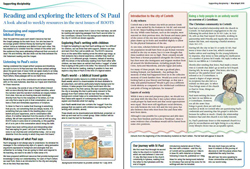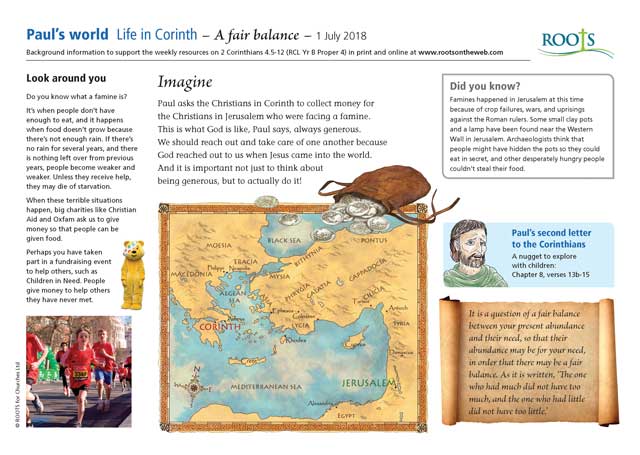A look ahead to weekly resources in issues 95 and 96 of ROOTS

View this article as a PDF
Encouraging and supporting biblical literacy
Over the past three years each week’s resources has had the Gospel passage as the main focus. Our aim has been to encourage greater biblical literacy by hearing the Gospel writers’ voices as individual and distinct from each other. This has enabled us to consider how the context of the writer and the audiences they were addressing influenced their accounts of Jesus’ life and ministry. We also drew out the links between the Old Testament reading and the Gospel.
Listening to Paul’s voice
Having considered the Gospel writers’ purpose and intentions, we want to turn to St Paul and hear how these earliest writings about the good news of Jesus Christ can speak clearly to us today. During Ordinary Time, when the lectionary gives us extracts from Paul’s letters, these passages will be our main focus. Rachel Nicholls, one of the contributors we’ve been working with on the new materials, describes our hopes and intentions for these resources:
‘In one sense, the words of one of Paul’s letters interact with us more directly than even a Gospel narrative, where the narrator (and the narrator’s motives) are largely hidden from view. Here we are hearing ideas and challenges directly from Paul to the recipients of his letters, so if we can only find a way to join in that conversation, we can have a fresh and immediate experience of Scripture.
To listen to Paul is to realise that theology is something that you do, not something that you simply receive. It is something that you make in the meeting place of your beliefs and your experience, and in conversation with others. It is neither detached from the events of life nor solitary. We all have experiences in life and all will be using ROOTS notes in some kind of community, so this qualifies all of us to join in this conversation about living the faith.
People have been writing about and interpreting what Paul was saying for years. Let’s join in and listen to his voice in our churches and communities today – not so very dissimilar from the society in which they were first heard.’
Making sense of what Paul says
Paul’s language is not always easy to understand. He dictated his messages in the contemporary style of a speech, using persuasive arguments expressed in metaphors and analogies that are unfamiliar to us today. If we are going to listen and respond to his teaching, we need to be able to make sense of it.
We have prepared additional resources that provide background knowledge to help our understanding. For each of Paul's letters we read from, there is an introduction to the city and everyday life at the time Paul was there.
For example, for six weeks from 3 June in the next issue, we will be reading and exploring passages from Paul’s second letter to the Corinthians. Extracts from the background material about the city of Corinth are shown opposite.
Exploring Paul’s writing with children
It might be tempting to say that Paul’s writings are ‘too difficult’ for children, but we think that with support, children can hear and learn from Paul, just as adults can. The ROOTS resources focus on the same Bible reading across the whole age range, so that everyone has a shared experience, whether they meet all together, or in different groups. However, instead of working with the whole of the lectionary reading from Paul’s letter with children, we have taken an extract that holds a ‘nugget’ of what Paul is saying at this point in his letter. The resources for children focus on this shorter reading, making it possible to hear and explore a key idea of Paul’s in the time of a typical session.
Paul’s world – a biblical travel guide
An additional weekly resource is a biblical travel guide, Paul’s world, which is a downloadable A4 sheet available to all subscribers, and will be particularly helpful background for children. It takes people from today’s world back into the Roman Empire in the first century. We learn something about the city or everyday life that is particularly relevant to the passage from Paul’s letters that we hear that week. This background context helps us to understand the comparisons Paul makes with aspects of contemporary life in order to explain and illustrate what he’s saying.
Each Paul’s world sheet also contains the ‘nugget’ from the passage that we explore with children (see Exploring Paul’s writing with children, above).
These sheets can be downloaded and distributed, projected, or held up and read out to a small group. Older children will be able to read the text for themselves.
 |
|
Background information to provide context for 1 July 2018.
|
| |
|
|
|
|
| |
|
Introduction to the city of Corinth
A city reborn
Corinth was a new Roman city with an ancient Greek past. It was sacked by the Romans in 146 BC and restored in 44 AD. Major building work was needed to recreate the city. While some features, such as the temples, were restored on their previous sites, the forum and many parts of the centre of the city were remodelled according to plans drawn up in Rome and modified slightly to allow for the physical limitations of the site.
At one time, scholars believed that a good proportion of the population would have been ex-pat Roman veterans settled in the city en masse, but it is now thought that these numbers were not so high. There certainly would have been a Roman population alongside the Greek one, but there were also immigrants and migrant workers from all around the Mediterranean, including people from Crete, Syria and Macedonia, and also Egypt and Judea.
For many of these people, this was a go-ahead place, looking forward, not backwards – but perhaps the memory of what had happened lived on in the collective memory of Greek families there. Would you tend to avoid looking back at your history and heritage, as that was a risky and painful business? Would it give you a different Greek identity as compared to the intellectual confidence and pride of being an Ephesian, for instance?
Layers of society
While it was a new and prosperous place, we should not run away with the idea that it was a place where anyone could prosper by hard work and that social opportunities were equal. There were still significant social divisions, not only between the very rich and the very poor, but also between those who were born free and those who were born slaves. Although it was possible for a prosperous and able slave to buy their freedom and become a ‘freedman’, there is some evidence that a freedman would still be barred from some civic positions.
[This is an extract from Rachel Nicholls introduces life in Corinth.]
|
|
|

Credit: Geoffrey Hayes
Being a holy people in an unholy world
An overview of 2 Corinthians
The Christian community in Corinth
Paul had a troubled relationship with the church in Corinth. He had planted congregations in the city following his arrival there in 50 AD. Luke, in Acts 18, tells us that Paul stayed 18 months, working in partnership with Priscilla and Aquila who were tent makers like him, and enjoying a fruitful ministry (Acts 18.1-17).
Having left the city in late 51 or early 52 AD, Paul wrote a letter that is now lost, which contained further advice and teaching for the young believers. In response, they wrote to him asking for clarification of a number of points he’d made. His reply is what we have in our Bibles as 1 Corinthians.
Shortly after sending that letter, Paul made a return visit to Corinth that didn’t go as well as he’d hoped. Having left, he wrote again. This letter, also lost, is known as ‘the painful letter’ and is referred to in 2 Corinthians. It caused a degree of anger among its recipients but also led to a rethink on their part. So when Titus brings news of the church to Paul in Troas, things are looking up.
Paul starts writing the letter we have in our Bibles as 2 Corinthians. However, not all the news Titus brings is good; there are still rival teachers at work in Corinth who are questioning Paul’s credentials and asserting that his gospel is defective because he suffers so much. Clearly the relationship between Paul and this church is not fully restored.
So, Paul’s passionate letter to this wayward church is a plea for reconciliation and right living in a city where every lifestyle choice was an acceptable option.
[This is an extract from Being a holy people in an unholy world.]
Our journey with St Paul
We first meet Paul through his second letter to the church in Corinth from which we read between 3 June and 15 July. We then move to the church community in Ephesus, reading from the letter to the Ephesians until the end of August.
Introductory material about St Paul – the man with a mission – and the city of Corinth will be published on 1 March in Issue 95; with material on Ephesus following in Issue 96, published on 1 May. Ideas for using the background material to introduce Paul and set the scene for his writings will also be included.
We very much hope you will be keen to embark on this journey of discovery to visit the places where Paul established the early churches and to hear his voice speaking to those communities and down the years into our world today.
|